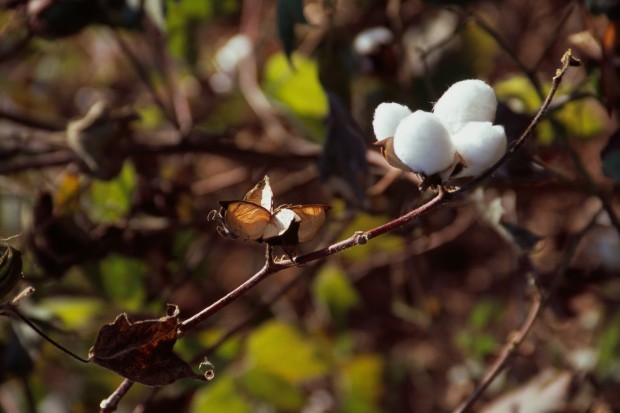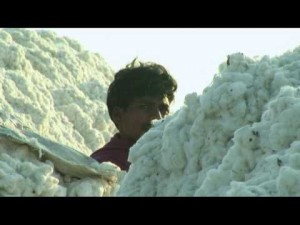You have no items in your cart. Want to get some nice things?
Go shopping
It strikes me that the film, Cotton for my Shroud, has an ominous title with various connotations. The word “shroud” refers to a cloth used to wrap a body for burial. It can also mean a thing that screens, obscuring something from view. It is, additionally, something that protects. The first definition is evoked most directly in this film, which follows the lives of cotton farmers and their families in Maharashtra, India, home of the highest recorded suicide rate in the world today. As an investigative piece of journalism, the film exposes and explores the untold stories that have been shrouded by these statistics. And in the compassion they demonstrate for their subject matter, filmmakers Kavita Bahl and Nandan Saxena have carefully weaved a narrative that incorporates human rights into the contemporary history of the global textile industry.
Whilst watching the film I recalled the artist Celine Condorelli’s installation White Gold (2012), featuring a large curtain with the printed image of a farmer in a cotton field, behind which an archive of records and information relating to the textile industry is encased in a bolted steel structure with glass panels. This knowledge has been at once screened, contained and protected by Condorelli’s intervention. White Gold was a commission for an exhibition entitled Social Fabric at Iniva (Institute of International Visual Arts), London, in 2012. It considered different aspects of the textile history, exploring the associated colonial history, international trade, labour and militant politics. This comprehensive and rigorously curated show took its departure from Karl Marx’s accounts of the cotton industry in the 19th Century that appeared in the New York Daily Tribune in 1853. Marx recalled the historical impact of the colonial East India Company, tracked fifty years of boom and bust and considered the effect this had on workers from Britain and its colonies, particularly India.
“Today we face another onslaught on our independence,” warns Kavita Bahl in the narration to Cotton for My Shroud. The film’s concerning message is made clear: whoever controls seed distribution has the power over all agricultural production. The international agricultural company Monsanto has taken control of seed production and distribution, forcing it out of the hands of farmers. India won independence from Britain in 1948, but if a country has no agricultural security, it cannot be considered independent.

Multinationals are a silent enemy here, with the government of India the shameless partners in crime. Cotton for my Shroud is a polemic piece of film-making and its perspective is, on the whole, as grey and bleary as the film’s opening shots: a view from the window of a moving car in the driving rain. Elsewhere the camera peers through naked cotton shrubs resembling barbed wire. Even the mountainous piles of white fluffy cotton are a disquieting sight: a harvest of stockpiled strife, accompanied by mounting debts.
Whereas the view from the Social Fabric exhibition was rigorously historical and critical, Cotton for my Shroud is more of a journalistic enquiry into the lives of the people behind the suicide statistics, from which the impetus for the film came. It aims to consider the human impact, rather than the statistical impact, of the multinational companies that have been imposing “cash crops” and modern farming techniques on farmers who were previously self-sufficient. Political context for these stories is provided by the filmmakers’ own narration and from speeches and interviews with NGO representatives, particularly Vidarbha Jan Andolan Samiti who were a supporter of the film.

Although the focus is on the lives of the afflicted farmers, it is really only the afflicted parts of these peoples’ lives that are accounted for, and as a result the film cannot avoid being desperately sad. “My eyes are overflowing with tears,” explains Jayawanta Mahadu Meshram, the father-in-law of a deceased farmer, in an interview with Nandan Saxena, who sits listening, looking into his eyes and nodding sadly. There is a pause of silence. You get the impression that she feels as helpless sitting next to him as we do as viewers gazing at the screen; like the lizard filmed staring up from the ground with eyes boggled and mouth agape.
“We are trying to solve your problem only,” we hear a media journalist appeal to a protesting farmer who has disrupted her interview with the Guardian Minister. The farmer is unconvinced. “Just covering this for TV is not going to solve the problem. Even if you show this to the whole world, in the end, we only have to solve everything.” Amongst the desperation, the sense of helplessness and heartbreak in the film, it is encouraging to see and hear strong dissenting voices with clear demands coming from within the farming communities, and not just from the NGOs and government bodies gathered for a conference in faraway Delhi called – somewhat bizarrely – “Summit of the Powerless”. This is what gives this compassionate film its vital relevance. The filmmakers hope that Cotton for my Shroud will be translated into regional languages throughout India and shown to other farming communities with similar problems to share.
Farmers, not just in Maharashtra but elsewhere, from formally self-sustaining communities, are being systematically forced into suicide by their mounting debts imposed by multinational companies. So many lives lost in the same community cannot be simply a series of suicides, it is a genocide. Yet the enormity of these preventable deaths has been overlooked by politcians and by the press. The film subsequently questions what the value of a life is. How is it possible that one life could be considered more valuable than another? “When a fire engulfs a factory, the body of those trapped inside burns in the same way, regardless of who they are,” writes Shuddhabrata Sengupta in a harrowing article for the Indian journal Kafila that warns of the countless deaths of factory workers in India that go unaccounted for:
“Day after day, as the names slide off the ESI registers and muster rolls, a legion of ghosts gathers on the shop-floor. . . The risque, robust dance of the seemingly inevitable trio of death, taxes and wage-slavery pauses, straining to listen for the music of the machines on the assembly line. It hears silence instead. Could it be that a spectre is haunting our factories?”
The reference to Marx here is deliberate and provocative. It also recalls for me the closing scene of Cotton for my Shroud where a family, recently bereft, sits around the deceased draped in funeral shroud, outside their home at night. As the credits roll, all is still and silent, except for the humming of wildlife, until a dark figure drifts in front of the camera. For a moment it is undistinguishable, until it steps into the light and it is revealed to be a local dog. This moment, however, seems to indicate a dark presence; something wild that is yet to be determined.
You can see Cotton for my Shroud at Investigative Film Week in London, alongside a programme of exciting investigative documentaries from around the world, from 15-19 January.

About Becky Ayre
Becky is a writer, editor and researcher of visual arts and the environment. She lives in Oxford. She works collaboratively with Inheritance Projects—a small group of independent curators and researchers that organise exhibitions, events, new commissions, publications and research projects. She blogs at Atmospheres of Uncertainty.





Becky,
This is the most poignant write-up on the film till date.
I admire your reading of the subtext and the import of the elements we use as metaphor.
Yes, it is a sad commentary on what goes on in our fast-changing world, in the name of progress. We believe that we are farmers ourselves- sowing the seeds… hoping for change.
All kindred souls must work together to save whatever we can save for the future generations.